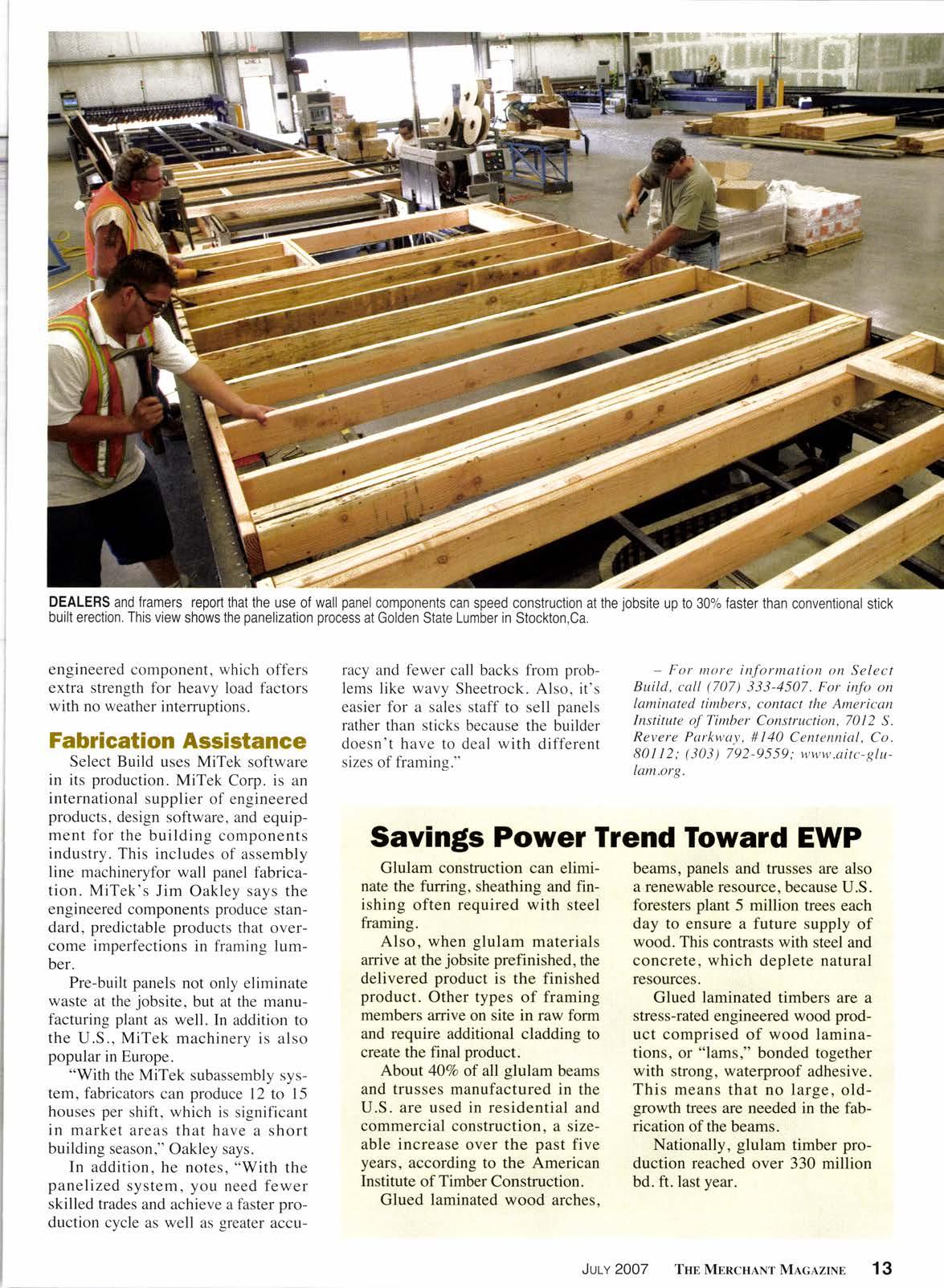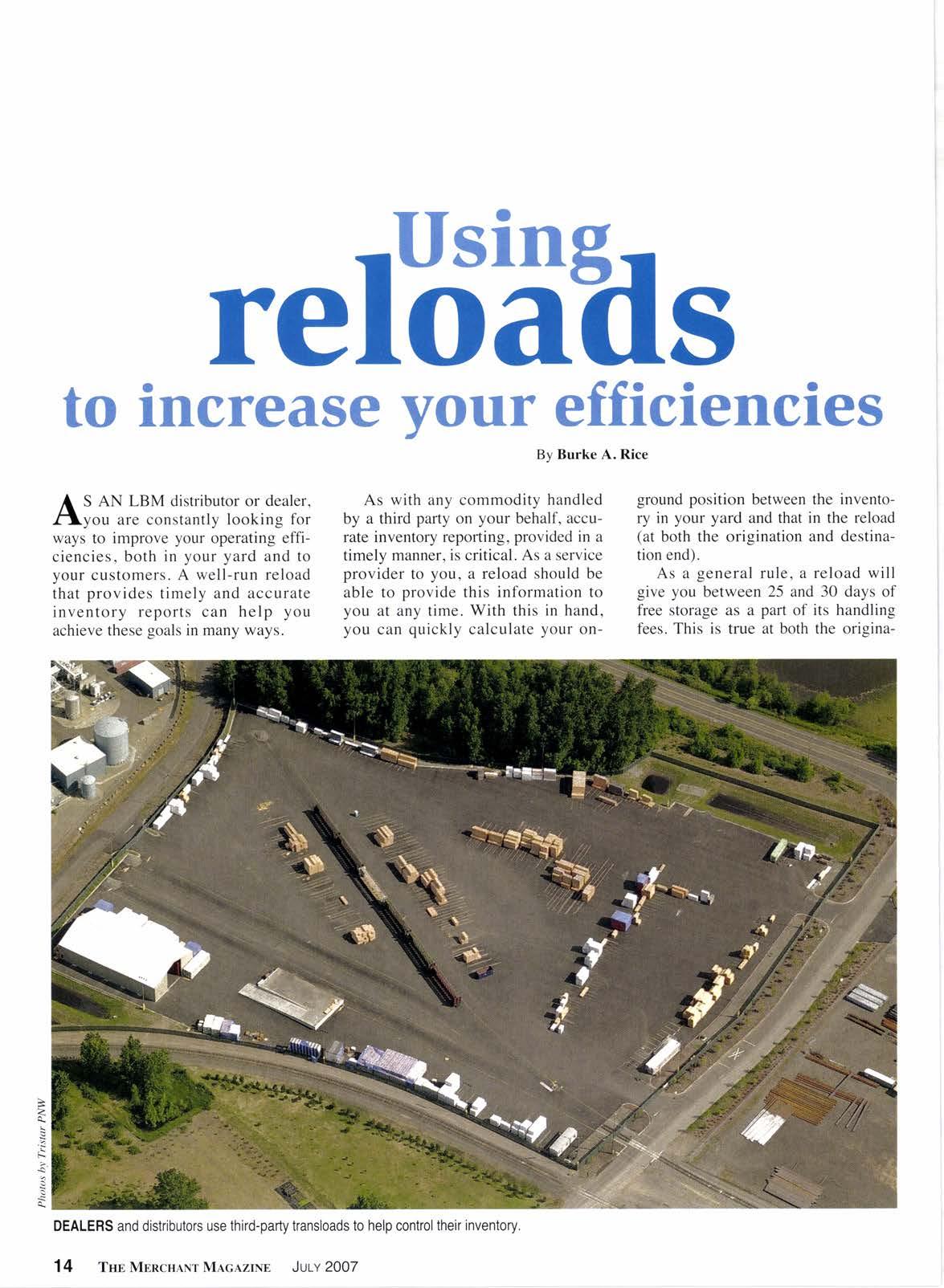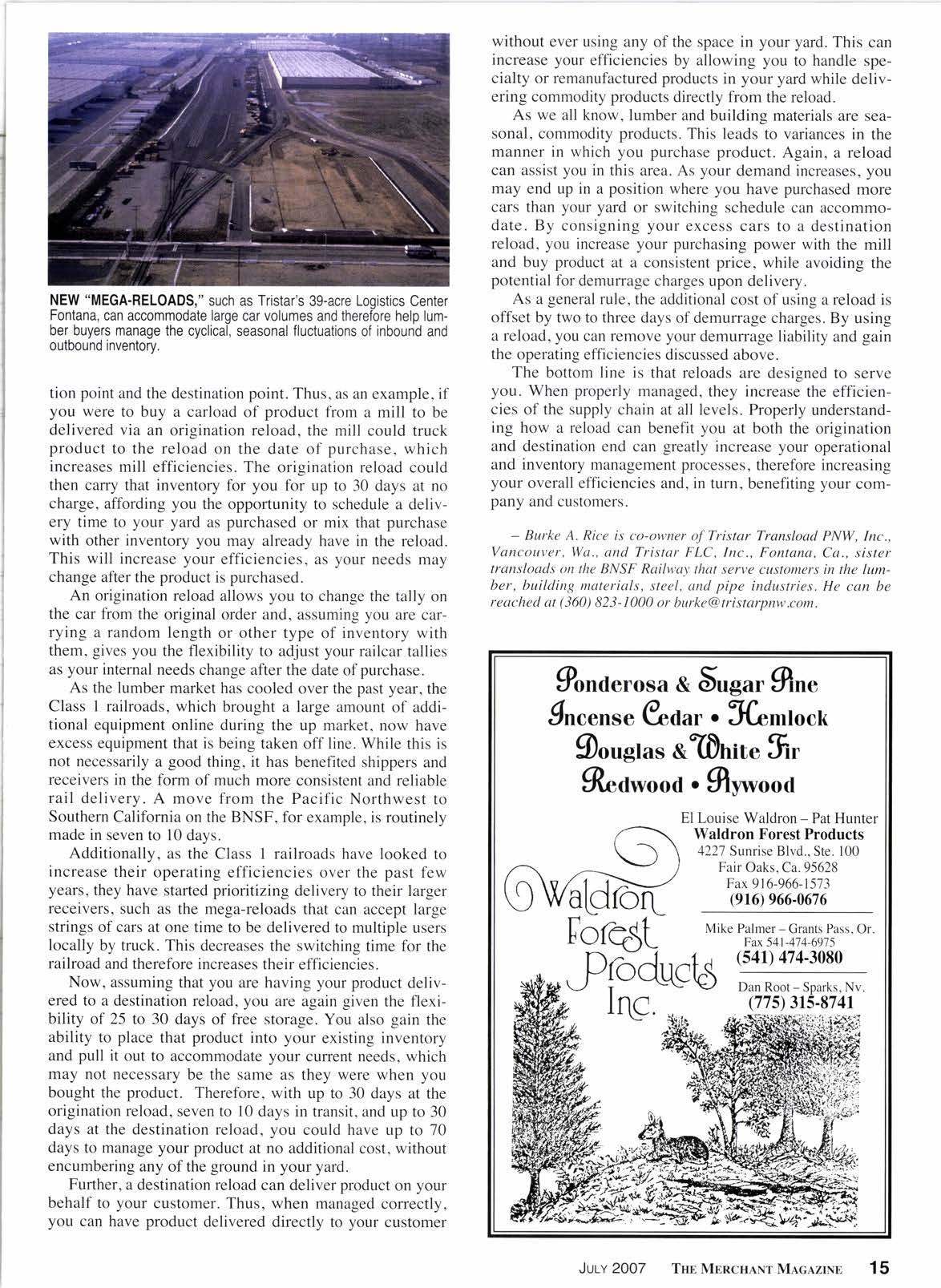
5 minute read
Engineered wall panels reduce stick built construction
IatONSTRUCTION with pre-built \-,walls panels is gaining marketshare because of its engineered quality and speed of erection.
One regional leader in panelized wall sections is Select Build Inc.. serving Northern California and the rest of the West Coast.
Select Build assembles the wall section for delivery to builders and also operates retail construction service distribution yards.
Jeff Radich of Select Build says the main advantage of the component system is the faster cycle time it provides for single- and multifamily housing. "We're building about 3,500 homes annually and about half of them are engineered wall panel construction," he says. "We expect this percentage to grow because wall panels generate less waste that goes into the landfill, provide a cleaner job site, and help avoid theft of materials and the need to store a big volume of stick frame materials on the job."
Radich adds that these advantages are significant in today's highly competitive market. He notes, "Our percentage of component-type housing has increased substantially over the past five years."
Select Build specifies both glulam headers and solid sawn, stick-builtheaders and says the percentage of glulam headers will be increasing because of their strength for longer spans.
The panels are usually assembled with 2x4 or 2x6 lumber framing and plywood or OSB sheathing. Builders and framers like the pre-framed wall panels because they are a kiln-dried, engineered component, which offers extra strength for heavy load factors with no weather intemrptions.
Fabrication Assistance
Select Build uses MiTek software in its production. MiTek Corp. is an international supplier of engineered products, design software, and equipment for the building components industry. This includes of assembly line machineryfor wall panel fabrication. MiTek's Jim Oakley says the engineered components produce standard, predictable products that overcome imperfections in framing lumber.
Pre-built panels not only eliminate waste at the jobsite, but at the manufacturing plant as well. In addition to the U.S., MiTek machinery is also popular in Europe.
"With the MiTek subassembly system, fabricators can produce 12 to 15 houses per shift, which is significant in market areas that have a short building season," Oakley says.
In addition, he notes, "With the panelized system, you need fewer skilled trades and achieve a faster production cycle as well as greater accu- racy and fewer call backs from problems like wavy Sheetrock. Also, it's easier for a sales staff to sell panels rather than sticks because the builder doesn't have to deal with different sizes of framins."
- For more information on Select Build, call (707) 333-4507. For inJb on laminated timbers, contact the American Institute of Timber Construction, 7012 S. Revere Parkway, #140 Centennial, Co. 801 l2 ; (303 ) 792-9559 ; www.aitc-slulam.org.
Savings Power Trend I'ioward EWP
Glulam construction can eliminate the furring, sheathing and finishing often required with steel framing.
Also, when glulam materials arrive at the jobsite prefinished, the delivered product is the finished product. Other types of framing members arrive on site in raw form and require additional cladding to create the final product.
About 40Va of all glulam beams and trusses manufactured in the U.S. ate used in residential and commercial construction, a sizeable increase over the past five years, according to the American Institute of Timber Construction.
Glued laminated wood arches.
beams, panels and trusses are also a renewable resource, because U.S. foresters plant 5 million trees each day to ensure a future supply of wood. This contrasts with steel and concrete, which deplete natural resources.
Glued laminated timbers are a stress-rated engineered wood product comprised of wood laminations, or "lams," bonded together with strong, waterproof adhesive. This means that no large, oldgrowth trees are needed in the fabrication of the beams.
Nationally, glulam timber production reached over 330 million bd. ft. last year.


NEW "MEGA-RELOADS," such as Tristar's 39-acre Logistics Center Fontana, can accommodate large car volumes and therelore help lumber buyers manage the cyclical, seasonal fluctuations of inbound and outbound inventory.
tion point and the destination point. Thus, as an example, if you were to buy a carload of product from a mill to be delivered via an origination reload, the mill could truck product to the reload on the date of purchase, which increases mill efficiencies. The origination reload could then carry that inventory for you for up to 30 days at no charge, affording you the opportunity to schedule a delivery time to your yard as purchased or mix that purchase with other inventory you may already have in the reload. This will increase your efficiencies, as your needs may change after the product is purchased.
An origination reload allows you to change the tally on the car from the original order and, assuming you are carrying a random length or other type of inventory with them, gives you the flexibility to adjust your railcar tallies as your internal needs change after the date ofpurchase.
As the lumber market has cooled over the past year, the Class I railroads, which brought a large amount of additional equipment online during the up market, now have excess equipment that is being taken off line. While this is not necessarily a good thing, it has benefited shippers and receivers in the form of much more consistent and reliable rail delivery. A move from the Pacific Northwest to Southern California on the BNSF, for example, is routinely made in seven to 10 days.
Additionally, as the Class I railroads have looked to increase their operating efficiencies over the past few years, they have started prioritizing delivery to their larger receivers, such as the mega-reloads that can accept large strings of cars at one time to be delivered to multiple users locally by truck. This decreases the switching time for the railroad and therefore increases their efficiencies.

Now, assuming that you are having your product delivered to a destination reload, you are again given the flexibility of 25 to 30 days of free storage. You also gain the ability to place that product into your existing inventory and pull it out to accommodate your current needs, which may not necessary be the same as they were when you bought the product. Therefore, with up to 30 days at the origination reload, seven to 10 days in transit, and up to 30 days at the destination reload, you could have up to 70 days to manage your product at no additional cost, without encumbering any ofthe ground in your yard.
Further, a destination reload can deliver product on your behalf to your customer. Thus, when managed correctly, you can have product delivered directly to your customer without ever using any of the space in your yard. This can increase your efficiencies by allowing you to handle specialty or remanufactured products in your yard while delivering commodity products directly from the reload.
As we all know, lumber and building materials are seasonal, commodity products. This leads to variances in the manner in which you purchase product. Again, a reload can assist you in this area. As your demand increases, you may end up in a position where you have purchased more cars than your yard or switching schedule can accommodate. By consigning your excess cars to a destination reload, you increase your purchasing power with the mill and buy product at a consistent price, while avoiding the potential for demurrage charges upon delivery.
As a general rule, the additional cost of using a reload is offset by two to three days of demurrage charges. By using a reload, you can remove your demurrage liability and gain the operating efficiencies discussed above.
The bottom line is that reloads are designed to serve you. When properly managed, they increase the efficiencies of the supply chain at all levels. Properly understanding how a reload can benefit you at both the origination and destination end can greatly increase your operational and inventory management processes, therefore increasing your overall efficiencies and, in tum, benefiting your company and customers.
El Louise Waldron - Pat Hunter Waldron Forest Products 4227 Sunrise Blvd., Ste. 100 Fair Oaks, Ca.95628 Fax 916-966-1573 (916) 966-0676
Mike Palmer - Grants Pass. Or. Fax 541-474-6975 (s41) 474-3080
Dan Root - Soarks. Nv. 07s\ 3rs-874r










